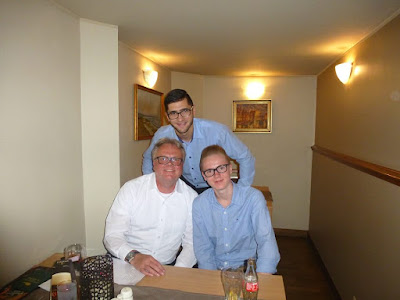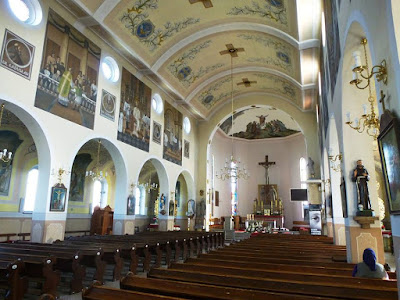by Michael Pionke
In my first articles, I have led you into the past. We have investigated the potential
meaning and origin of our rare surname, and we have discovered the unique story of our very own Adam and Eve from Będargowo (read
here and
here). This time, we don’t need our time machine. We will walk on the trails of our ancestors in modern Poland.
My travel report covers two journeys to our ancestral home region, which I carried out with my son Jannik in 2015 and 2016. On our second journey, we were accompanied by my distant cousin and friend Witold Pionke, who was born and grew up in Luzino in Poland, and who now has lived in Germany for many years. Witold is an excellent expert of the Kashubian history and area. Thus, both journeys were also part of a German-Polish family reunion.
Gdańsk - Historical city and pearl of the Baltic Sea
If you ever decide to visit the home country of our ancestors, you should start your journey with the city of Gdańsk (German: Danzig). Gdańsk is one of the most beautiful cities I have ever seen. It has a rich and moving history as a trading and fishing port along the Baltic Sea coast. Together with the adjacent cities of Gdynia and Sopot, Gdańsk forms the so-called Tri-City (Polish: Trójmiasto), an important Polish business location and metropolitan area with a population of over 1 million people.
Based on older Slavic and Prussian settlements, the city of Gdańsk was founded in 1224 by German merchants under German city rights, who were invited by the Pomerelian Dukes to enhance trade in that region. Due to its excellent location on the coast, Gdańsk developed into a thriving metropolis and Hanseatic City, and was also referred to as the Venice of the East. Although Gdańsk/Danzig was characterized by German culture and language for more than 700 years, it was an essentially independent city with many privileges. The inhabitants of Gdańsk stood loyal to each of their many sovereigns, who changed several times in history, e.g. the Pomerelian Dukes, the Teutonic Knights, the Polish crown, and the German Prussians.
A sad high point of the city history was the German attack on the Polish military depot at Westerplatte on 1 September 1939 which marked the start of World War II. After World War II, the city became part of Poland and the German population either fled or was expelled to Germany. Fortunately, the majority of our Kashubian ancestors could remain in their home region. Thus, the Kashubian region is still inhabited today by the descendants of the Slavic natives who have been settled in the area since the Migration Period in the early Middle Ages (6th century).
After World War II, the inner city of Gdańsk was 90% destroyed. We must be very grateful that the Polish and Kashubian people have restored the city true to original. Today, the modern city with its historical charm welcomes many visitors from all over the world.
A good overview of the history of Gdańsk is given in the following article:
https://en.wikipedia.org/wiki/History_of_Gda%C5%84sk
Our Kashubian ancestors from the eighteenth and nineteenth centuries lived in the countryside in the small parishes of Strzepcz, Kielno, Luzino, and Prodzodkowo about 20-30 miles northwest of Gdańsk. Our Pionke/Piontke namesakes from the Puck area lived about 30 miles north of Gdańsk on the Baltic Sea.
According to the West Prussian Land Register from 1773, we know that our ancestors from the small village of Będargowo bought their spirits in Gdańsk. We can assume that our ancestors visited the markets in order to sell their rural products or to buy merchandise which was not available in the countryside. Presumably, it was always a particular highlight for them to visit the big city, and a strenuous trip, too.
However, the social differences between the rural population on the one hand and the urban population on the other hand must have been high. The wealthy town citizens of Gdańsk were well-educated with good prospects and a comfortable life. In contrast to that, most of the country people led a poor and modest life as farmers, farm workers, foresters, black smiths, and day laborers. In the first half of the nineteenth century, the majority of our Kashubian ancestors could not read and write.
It took until the late nineteenth century, for the first Pionke families to move from the rural side to Gdańsk, and that was mainly my family branch. My great-grandfather Peter Pionke was born in 1864 in Kielno. After several engagements as farm worker at different locations, he came around 1896 to Sopot, a maritime suburb of Gdańsk, where he worked as fireman to keep the steam engines in the factories going.
For my great-grandfather, the change from the poor rural life to the modern life in the industrial center was a social advancement. My family became fully Germanized in Gdańsk and migrated after World War I to the coal fields in the Western German Ruhr area. That’s the reason why I was born in Germany. Over time, my family repressed and finally forgot their Kashubian identity. It really took me a long time to rediscover the lost family history, and Witold was a good teacher to explain the Kashubian history and customs. Today many of our Polish Pionke relatives live in Tri-City and its surroundings.
Coming back to my journeys to Poland, Gdańsk was our starting point in 2015. Figures 1 to 5 give you an impression of this beautiful city. In addition, Gdańsk was also the place of our first German-Polish family reunion. We met my fourth cousin once removed Patryk Pionke whose family lives in Gdynia in Tri-City (Fig. 6). The photos in Figures 7 and 8 were taken in Sopot, the very own homeland of my family line.
 |
| Fig. 1: Old Town of Gdańsk - Long Market with Main Town Hall. |
 |
Fig. 2: Long Market - Neptune’s Fontain with Artus Court
(white building in the background). |
 |
| Fig. 3: The Golden Gate in Gdańsk. |
 |
Fig. 4: View of the city from St. Mary's Church at 82 m. |
 |
| Fig. 5: Long Wharf with medieval Crane at river Motława. |
 |
Fig. 6: Family reunion 2015 in Gdańsk.
From left to right: Michael, Patryk, and Jannik Pionke. |
 |
Fig. 7: Sea-bridge in Sopot, a maritime suburb of Gdańsk.
With a length of 511.5 m, the pier is the longest wooden pier in Europe. |
 |
| Fig. 8: Beach at Sopot in October. |
The following map shows the main routes and locations of our two trips to Poland.
Fig. 9: Main route of the two trips to Poland. (view map here)
Będargowo - Cradle of the Pionke family history
When you leave Gdańsk to the west, you will reach the Kashubian countryside after a few miles only. In contrast to the metropolitan area of Tri-City, the Kashubian countryside is sparsely populated with small settlements. The beautiful landscape is characterized by extensive fields, green meadows and pastures, gentle hills, forests, and small lakes. You will not find any larger industry here. For the people who don’t work in Tri-City, farming is still the main source of income.
After a fifty minute ride, you will arrive at Będargowo. The town sign tells you that you have reached the cradle of the Pionke family history (Fig. 10).
 |
| Fig. 10: Entrance to the village of Będargowo. |
According to the West Prussian Land Register, only 63 people lived in that small village in 1773. It seems that Będargowo has not grown very much until today. There are no shops or public buildings. Będargowo is rather a loose cluster of buildings than a compact village (Fig. 11, 12). During both visits in 2015 and 2016, we did not meet any person outside.
 |
| Fig. 11: Farm house in Będargowo. |
 |
Fig. 12: Wayside cross in Będargowo.
The Catholic population in Poland is very religious. |
Unfortunately, we could not find any historical building. Thus, we searched in vain for the former manor house of landlord Donimierski. However, we can assume that the landscape did not change very much over time. Therefore, we enjoyed the view on the fields and meadows (Fig. 13, 14). For a short moment, I wished my 3rd great-grandfather, the forester Michael Pionk, would have come out of the woods.
 |
| Fig. 13: Fields and farms in Będargowo. |
 |
| Fig. 14: View of the fields, meadows and forests in Będargowo. |
Będargowo does not provide any spectacular sights. It is not Grand Canyon or Niagara Falls. However, if you are aware about the importance of that inconspicuous place for your own family history, it is a very special moment to stand on the ground of your earliest ancestors.
Strzepcz - Our very own St. Mary
We continue our journey to Strzepcz, crossing through other well-known villages from our genealogical research like Łebieńska Huta, Łebno, and Zęblewo. Compared to the other small settlements in the vicinity, Strzepcz is a larger village with about 766 inhabitants and a compact town center.
The Roman Catholic parish of Strzepcz has a rich history. According to the oldest documents, the parish dates 1314. From oral tradition and written sources we know that Strzepcz was a place of St. Mary’s cult and pilgrimages. In the 18th and 19th centuries the parish comprised up to one hundred very small villages and hamlets within a radius of only ten miles.
The Catholic church of St. Mary Magdalene was built and respectively rebuilt five times in history. The first three wooden churches were built in the fourteenth and sixteenth centuries, and in 1686. A half-timbered church was built in 1820 (for a photo, see my first article about Będargowo). Fire was the reason for the necessary reconstructions of the wooden churches. The present brick church was built in 1948/1949 (Fig. 15, 16). The interior of the church is very beautiful (Fig. 17). Take your time for a contemplative moment in the silence. St. Mary Magdalene Church is located on a hill. At the foot of the hill, you can walk along an idyllic lake (Fig. 18).
 |
| Fig. 15: St. Mary Magdalene Catholic Church in Strzepcz. |
 |
| Fig. 16: Two happy Pionkes at their very own St. Mary (Witold and Michael Pionke). |
 |
| Fig. 17: In the interior of St Mary Magdalene Church. |
 |
| Fig. 18: Lake in Strzepcz. |
More information regarding the Roman Catholic parish of Strzepcz can be obtained from following website:
http://parafiastrzepcz.pl/
Although Będargowo is only 6 miles away from Strzepcz, the church visits by foot through the hilly landscape must have been quite exhausting walks for our religious Kashubian ancestors. The church must have played an important role in their life, and was a regular meeting place with other relatives and the neighborhood.
On our second visit to Strzepcz in 2016, we used the chance to visit the local priest together with Witold, who is a native Polish speaker. We asked the priest about the old church books and in particular about the gap in the old documents between 1746 and 1810. Unfortunately, the corresponding church books got lost or were destroyed. Scans of the preserved documents are accessible in the archive of the diocese of Pelplin. Nevertheless, the priest provided us with valuable information before we continued our tour.


















